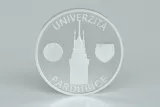Published: 01.10.2020
During the global developments concerning the spreading of the coronavirus, the academics and Ph.D. students from the Faculty of Chemical Technology, University of Pardubice have decided to help with the testing of samples of indicated patients for COVID-19. They started in the spring together with the Pardubice Region Hospitals. The testing team is led by the experienced scientist Mgr. Barbora Jankovičová, Ph.D. who not only put together the whole team but also organized the necessary preparations for the restart of the special BSL3 laboratory, which is in fact an independent unit in the FChT building. In the worsening epidemiological situation after the summer holidays and following the return of children and youth to schools, the testing capacity of 50 samples per day is helpful. The entire team is under the patronage of the Head of the Department of Biological and Biochemical Sciences Prof. Mgr. Roman Kanďár, Ph.D.
The devoted work of the six women in the testing team both in the spring and autumn months was awarded by the Dean of the Faculty Prof. Petr Kalenda by the “Silver Medal for Outstanding Work for the Faculty”. They were also awarded the Memorial Certificate. The testing procedure is performed manually using basic instrumentation, also because the grant for the modernization of the BSL3 biological safety test laboratory was not successful.
The testing team is mixed and includes the leading academic employee Mgr. Barbora Jankovičová, Ph.D., and three laboratory workers Bc. Renáta Čukanová, Bc. Ivana Fousová and Jana Kňavová. The team was also joined by two doctoral students Mgr. Nikola Mannová and Ing. Lucie Michalcová whose participation in the testing is an invaluable experience at the beginning of their scientific career.
“The Silver Medals” were awarded at the occasion of the meeting of the Scientific Board on 23 September in room C1. These were the first medals ever to be awarded.
Congratulations to all of the award winners and wishing them good health, fortune and every success!
The medals were made at the occasion of the 70th anniversary of higher chemical education in Pardubice, which is depicted on the reverse side of the medal by the dominant feature of the city—the Green Gate. The medal also shows the sign of the city, which is a half silver horse in a heraldic relief. This is the sign of the Lords of Pardubice that dates back to the 14th century. The city has used this sign since mid-16th century. According to a legend, this sign was acquired by the legendary knight Ješek of Pardubice during the siege of the northern Italian city of Milan in 1158. This event was depicted by the sculptor Bohumil Vlček in the western facade of the Green Gate according to a draft by Mikoláš Aleš.
The edge of the medal bears the name of the institution—The University of Pardubice. The medal weighs one ounce and is made of pure silver. It was made in a Czech medal-making workshop in the Czech Mint in Jablonec nad Nisou. The medal is coloured and the front side shows a “wave” in a heart-shaped flask in the colour of the Faculty symbolizing either blood in the heart or potassium permanganate solution in a flask. The connection between the two core disciplines at FChT (biology and chemistry) is symbolically unified in this inherent symbol of the Faculty. The main theme on the front side is a section from the Periodic table of elements, which is the basic stepping stone for the study of any chemical discipline. The medal also shows the logo of the Faculty including the inscriptions on the sides. There is also a small symbol at the bottom of the front side of the medal—the linden leaf, the symbol of Czech statehood. The linden tree officially became the national symbol in 1848 at the Pan-Slav Congress at the suggestion of F. L. Čelakovský. This was in response to the Frankfurt Assembly, where the oak tree was chosen the symbol of Great Germany. The linden tree is still a symbol of protection, help and love, especially because of its scent, graceful crown and amiable shade. People believed that it was able to drive away bad thoughts. In mythology, the linden tree was dedicated to the goddess of love, while in Christianity it was often associated with Virgin Mary. Its wood is popular for carving due to its softness.










